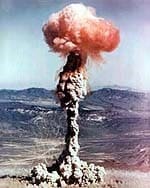Determining Deaths from a Radiation Emergency
Radiation emergencies—such as a nuclear detonation, dirty bomb, or nuclear reactor accident—can release radioactive materials into the environment. Exposure to radioactive materials can cause injury and death. It is important for medical certifiers such as medical examiners and coroners to understand the health effects of radiation so that they can accurately determine the illnesses or injuries that caused the death.
This fact sheet is supplemental to CDC’s A Reference Guide for Certification of Deaths in the Event of a Natural, Human Induced, or Chemical/Radiological Disaster.
Radiation Scenarios That May Cause Death
Nuclear Detonation
When a nuclear weapon detonates, everything inside the fireball vaporizes. The fireball rises rapidly, pulling debris up into it. This creates a mushroom cloud. As the fireball cools, the vaporized material condenses into small particles. The condensing particles trap nuclear-fission products, making them highly radioactive. Within 5 minutes of the explosion, the mushroom cloud stabilizes and starts to move downwind. Persons downwind from the explosion could be exposed to enough radiation from this fallout to cause sickness or death within a few days.
Dirty Bomb
A “dirty bomb” is a device that uses conventional explosives (e.g., TNT) to disperse radioactive material. Dirty bombs cannot cause mass casualties on the scale of nuclear explosions. All or most fatalities or injuries will probably be due to the explosion itself and not radiation effects. But dirty bombs can spread radioactive contamination. If the contamination gets into the body, also known as internal contamination, it may increase the risk of developing cancer years after the incident.
Nuclear Reactor Accident
A nuclear reactor accident can result in the environmental release of radioactive material that is present inside the reactor core. If the core is damaged severely, exposure to high doses of radiation will cause injuries and deaths. Unrelated trauma may also be involved. This will occur in potentially hazardous areas of the nuclear plant and would likely affect only workers or responders. Environmental contamination with radioactive material can lead to internal contamination of the public with radionuclides like iodine. This internal contamination may increase the risk of developing cancer years after the incident.

Questions that May Help You Determine
Radiation-Related Deaths
- Where was the decedent when the incident happened (i.e., specific address/location)?
- Were they inside a building/house?
- About how long were they outside?
- Did they vomit or have diarrhea? About what time did it start?
NOTE: Vomiting and diarrhea are symptoms of radiation injury. The time to onset of vomiting is roughly correlated to dose.
Initial Deaths and Delayed Deaths
A radiation emergency (from a nuclear detonation, dirty bomb, or nuclear power plant accident) may result in initial deaths during the emergency and delayed deaths after the emergency.
Initial deaths would occur at or near ground zero, caused by the blast, heat, prompt radiation, or flying debris.
Blast injuries would include perforated ear drums, lung and gastrointestinal injuries, trauma due to flying debris, fractures and crush injuries, smoke inhalation, and exacerbation of chronic conditions.
Heat or thermal injuries (from direct absorption of thermal energy) would include flash burns and flame burns caused by ignition of clothes or indirect effects of fires.
Delayed deaths would occur from
- Injuries sustained in the initial blast
- Acute Radiation Syndrome (ARS)
- Combination of injuries and ARS
Clinical effects decrease with increasing distance from the denotation; therefore, it’s important to know the location of injury or death of the decedent.
Exposure to radioactive materials also increases risk of malignancies years after exposure.
Deaths Caused by Acute Radiation Syndrome
Radiation emergencies may lead to Acute Radiation Syndrome. ARS occurs when a person is exposed to very high levels of radiation, usually over a short period of time. These 3 types of ARS may result in death:
- Hematopoietic syndrome (absorbed dose 0.70 – 6 Gy)
Nausea and vomiting (within hours), reduced lymphocyte count (1-2 days), reduced neutrophil and platelet count (days to weeks), infection, possible death within 30 days. Survival is possible, but less likely with combined injuries (thermal burns or trauma). - Gastrointestinal syndrome (absorbed dose 6 – 10 Gy)
Nausea and vomiting (within about an hour), reduced lymphocyte count (one day), reduced neutrophil and platelet count (less than one week), severe infection, bloody diarrhea, dehydration, death from 3 to 10 days. Very few will survive at this absorption dose level even with treatment. Survival not possible with combined injuries (thermal burns or trauma). - Neurovascular syndrome (absorbed dose 20 – 50+ Gy)
Nausea and vomiting (within minutes), mental status changes (disorientation), shock, cerebral edema, death within 48 hours. Survival not possible.
More information can be found:
HHS Radiation Emergency Medical Management Website
CDC Radiation Emergency Website
Triage and Treatment of Radiation and Combined-Injury Mass Casualties
Acute Radiation Syndrome: A Fact Sheet for Physicians
Guidelines in Handling Decedents Contaminated with Radioactive Material
Documenting Death Certificates
If you determine that radiation emergency played any role in the death, please document this on the death certificate. If the information is not recorded, it will be lost. The death will not be coded correctly, and the death will not be counted as related to the event.